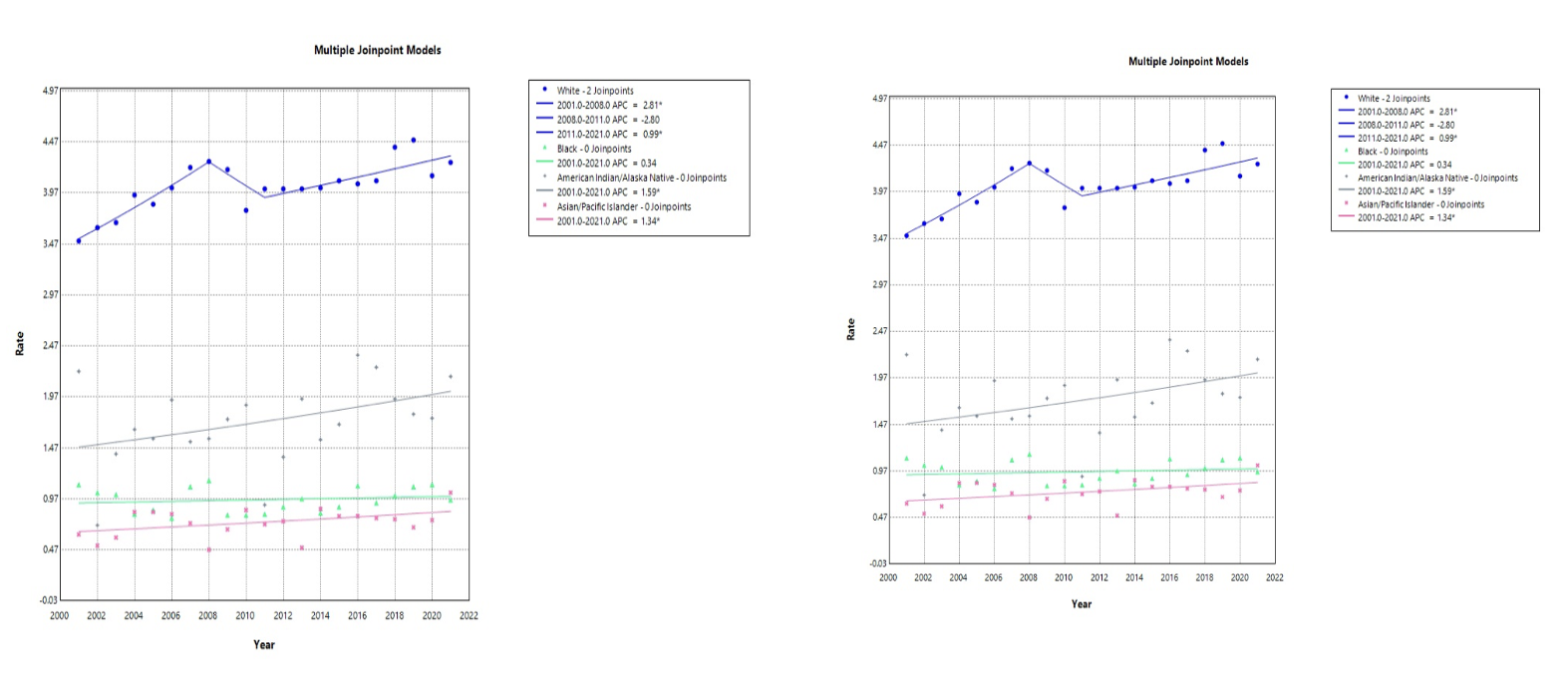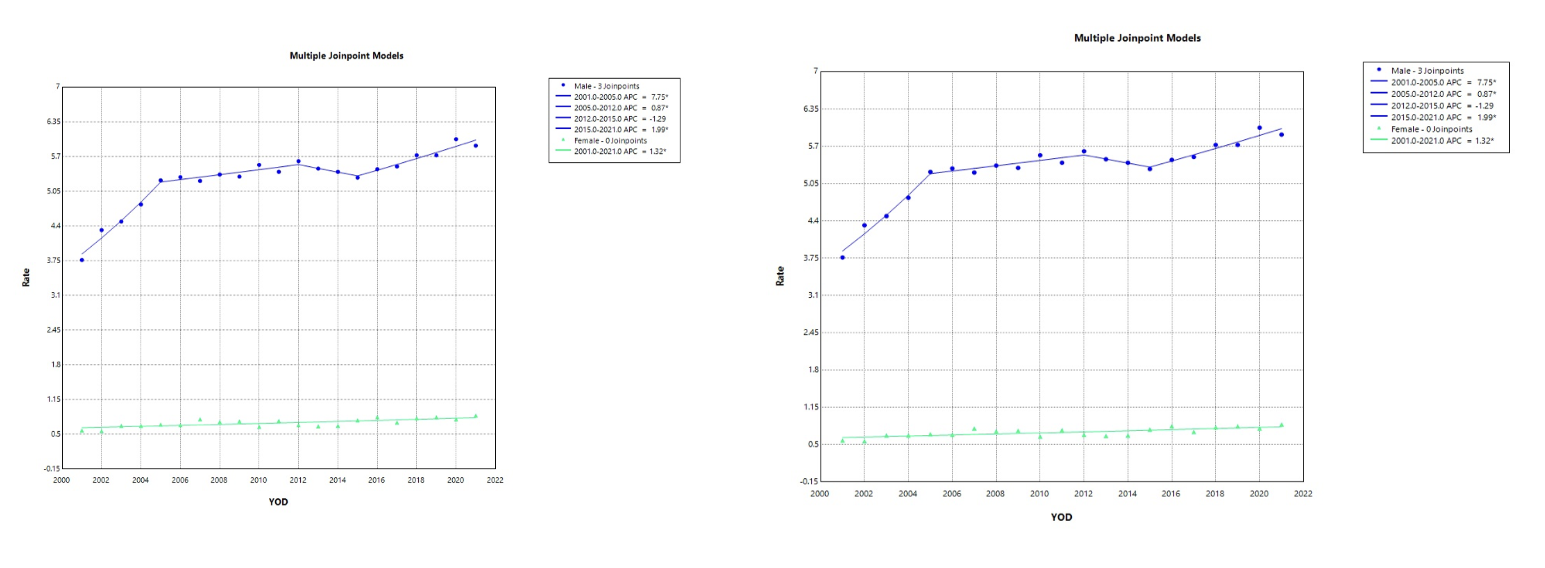Tuesday Poster Session
Category: Esophagus
P4877 - Racial and Gender Disparites in Esophageal Adenocarcinoma (EAC): A 20-Year-Trend Analysis from Surveillance, Epidemiology, and End Results (SEER) Database
Tuesday, October 28, 2025
10:30 AM - 4:00 PM PDT
Location: Exhibit Hall
- VM
Vamsee Mupparaju, MD
HCA Florida Healthcare Citrus Memorial hospital
Inverness, FL
Presenting Author(s)
Vamsee Mupparaju, MD1, Pujan Kandel, MD2, Gnanashree Dharmarpandi, MD1, Melvin Joy, MD3, Sreekanth Chandrupatla, MD4
1HCA Florida Healthcare Citrus Memorial hospital, Inverness, FL; 2HCA Florida Citrus Memorial Hospital, Gainesville, FL; 3HCA Healthcare Citrus Hospital, Inverness, FL; 4HCA Florida Healthcare, Lecanto, FL
Introduction: Esophageal adenocarcinoma (EAC) is the most common form of esophageal cancer in the Western world, with rising incidence over recent decades. EAC typically develops from Barrett’s esophagus, a condition resulting from chronic gastroesophageal reflux disease (GERD). In the U.S., EAC has surpassed squamous cell carcinoma as the predominant esophageal cancer type.
Methods: We used the SEER 22 registry database to analyze EAC trends from 2001 to 2021, focusing on incidence and incidence-based mortality (IBM). Age-adjusted rates stratified by gender and race were obtained using SEER*Stat version 8.4.4. Trends were assessed using the Joinpoint Regression Program version 5.3.0.0 (November 2024 release) with linear regression modeling to estimate Annual Percentage Change (APC).
Results: Among males, EAC incidence rose from 2001 to 2008 (APC: 2.29%, P < 0.05), declined from 2008 to 2011 (-3.15%, P < 0.05), and then rose modestly from 2011 to 2021 (0.48%, P < 0.05). In females, incidence increased steadily throughout the study period (APC: 0.7%, P < 0.05), though rates remained substantially lower than in males.
Racial disparities were prominent. Whites had the highest incidence overall. Recently, EAC incidence rose in American Indian/Alaska Natives (APC: 1.6%, P < 0.05), Asian/Pacific Islanders (1.3%, P < 0.05), and Whites (1.0%, P < 0.05).
IBM was consistently higher in males. From 2015 to 2021, male IBM increased at an APC of 2.0% (P < 0.05); female IBM rose at 1.3% annually (P < 0.05) over the full study period. Whites had the highest IBM across all races. Alarmingly, IBM in the Black population surged from 2018 to 2021 (APC: 10.4%, P < 0.05). IBM among American Indian/Alaska Natives also showed a steady rise from 2001 to 2021 (APC: 2.8%, P < 0.05).
Discussion: Significant disparities in EAC incidence and IBM exist across gender and racial groups. Males—particularly White men—exhibit the highest rates, though concerning upward trends are now evident in American Indian/Alaska Native and Black populations. These findings highlight the urgent need for targeted prevention, early detection, and intervention strategies among high-risk groups to address the rising burden of EAC.

Figure: Figure 1

Figure: Figure 2
Disclosures:
Vamsee Mupparaju indicated no relevant financial relationships.
Pujan Kandel indicated no relevant financial relationships.
Gnanashree Dharmarpandi indicated no relevant financial relationships.
Melvin Joy indicated no relevant financial relationships.
Sreekanth Chandrupatla indicated no relevant financial relationships.
Vamsee Mupparaju, MD1, Pujan Kandel, MD2, Gnanashree Dharmarpandi, MD1, Melvin Joy, MD3, Sreekanth Chandrupatla, MD4. P4877 - Racial and Gender Disparites in Esophageal Adenocarcinoma (EAC): A 20-Year-Trend Analysis from Surveillance, Epidemiology, and End Results (SEER) Database, ACG 2025 Annual Scientific Meeting Abstracts. Phoenix, AZ: American College of Gastroenterology.
1HCA Florida Healthcare Citrus Memorial hospital, Inverness, FL; 2HCA Florida Citrus Memorial Hospital, Gainesville, FL; 3HCA Healthcare Citrus Hospital, Inverness, FL; 4HCA Florida Healthcare, Lecanto, FL
Introduction: Esophageal adenocarcinoma (EAC) is the most common form of esophageal cancer in the Western world, with rising incidence over recent decades. EAC typically develops from Barrett’s esophagus, a condition resulting from chronic gastroesophageal reflux disease (GERD). In the U.S., EAC has surpassed squamous cell carcinoma as the predominant esophageal cancer type.
Methods: We used the SEER 22 registry database to analyze EAC trends from 2001 to 2021, focusing on incidence and incidence-based mortality (IBM). Age-adjusted rates stratified by gender and race were obtained using SEER*Stat version 8.4.4. Trends were assessed using the Joinpoint Regression Program version 5.3.0.0 (November 2024 release) with linear regression modeling to estimate Annual Percentage Change (APC).
Results: Among males, EAC incidence rose from 2001 to 2008 (APC: 2.29%, P < 0.05), declined from 2008 to 2011 (-3.15%, P < 0.05), and then rose modestly from 2011 to 2021 (0.48%, P < 0.05). In females, incidence increased steadily throughout the study period (APC: 0.7%, P < 0.05), though rates remained substantially lower than in males.
Racial disparities were prominent. Whites had the highest incidence overall. Recently, EAC incidence rose in American Indian/Alaska Natives (APC: 1.6%, P < 0.05), Asian/Pacific Islanders (1.3%, P < 0.05), and Whites (1.0%, P < 0.05).
IBM was consistently higher in males. From 2015 to 2021, male IBM increased at an APC of 2.0% (P < 0.05); female IBM rose at 1.3% annually (P < 0.05) over the full study period. Whites had the highest IBM across all races. Alarmingly, IBM in the Black population surged from 2018 to 2021 (APC: 10.4%, P < 0.05). IBM among American Indian/Alaska Natives also showed a steady rise from 2001 to 2021 (APC: 2.8%, P < 0.05).
Discussion: Significant disparities in EAC incidence and IBM exist across gender and racial groups. Males—particularly White men—exhibit the highest rates, though concerning upward trends are now evident in American Indian/Alaska Native and Black populations. These findings highlight the urgent need for targeted prevention, early detection, and intervention strategies among high-risk groups to address the rising burden of EAC.

Figure: Figure 1

Figure: Figure 2
Disclosures:
Vamsee Mupparaju indicated no relevant financial relationships.
Pujan Kandel indicated no relevant financial relationships.
Gnanashree Dharmarpandi indicated no relevant financial relationships.
Melvin Joy indicated no relevant financial relationships.
Sreekanth Chandrupatla indicated no relevant financial relationships.
Vamsee Mupparaju, MD1, Pujan Kandel, MD2, Gnanashree Dharmarpandi, MD1, Melvin Joy, MD3, Sreekanth Chandrupatla, MD4. P4877 - Racial and Gender Disparites in Esophageal Adenocarcinoma (EAC): A 20-Year-Trend Analysis from Surveillance, Epidemiology, and End Results (SEER) Database, ACG 2025 Annual Scientific Meeting Abstracts. Phoenix, AZ: American College of Gastroenterology.
